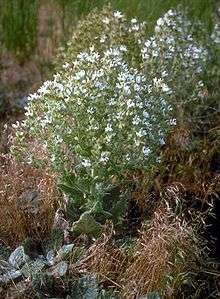Salvia aethiopis
| Salvia aethiopis | |
|---|---|
 | |
| Scientific classification | |
| Kingdom: | Plantae |
| (unranked): | Angiosperms |
| (unranked): | Eudicots |
| (unranked): | Asterids |
| Order: | Lamiales |
| Family: | Lamiaceae |
| Genus: | Salvia |
| Species: | S. aethiopis |
| Binomial name | |
| Salvia aethiopis L. | |
Salvia aethiopis is a species of perennial plant known by the common names Mediterranean sage or African sage. It is best known as a noxious weed, particularly in the western United States. It is native to Eurasia and was probably introduced to North America as a contaminant of alfalfa seed. It is a weed of rangelands and pastures. It is unpalatable to livestock, it disrupts native floral communities, and it becomes a physical nuisance due to its habit of becoming an abundant tumbleweed. The weevil Phrydiuchus tau is used as an agent of biological pest control on this plant.

Boya and Valderde examined a sample of Salvia aethiopis. Acetone extracts of the root furnished a new orthoquinone diterpene, aethiopinone (4,5-seco-5,10-friedo-abieta-4(18),5,6,8,13-pentaen-l1,12-dione). This compound was isolated in 0.15% yield from the dry roots.[1]
Notes
- ↑ Boya, Ma Teresa; Valverde, Serafin (1981). "AN ORTHOQUINONE ISOLATED FROM SALVlA AETHIOPIS". Phytochemistry. 20 (6): 1367–1368. doi:10.1016/0031-9422(81)80041-6.
External links
- Jepson Manual Treatment
- USDA Plants Profile
- "Salvia aethiopis". Plantarium (in Russian).

- Photo gallery